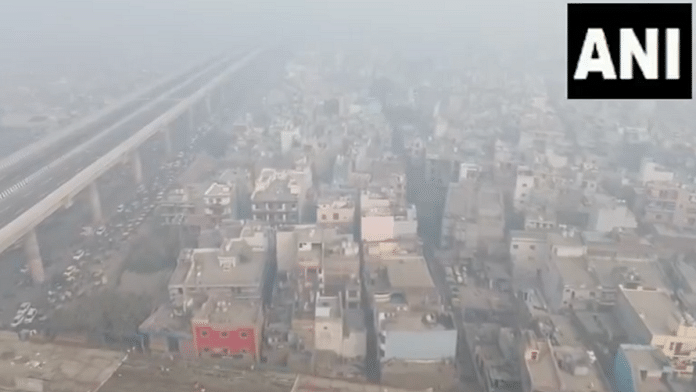
New Delhi: The air quality in the national capital continues to remain a concern amongst the people as the AQI reaches hazardous levels, falling under the ‘severe’ category and posing serious health threats including respiratory issues, eye irritation, and increased risk of cardiovascular problems. A dense layer of smog enveloped the city of Delhi for the fourth consecutive day and the Air Quality Index (AQI) was recorded at 406 as of 8 am on Saturday morning, according to the Central Pollution Control Board (CPCB). Drone visuals taken at 6.
45 am show a blanket of smog covering the entire area near All India Institute Of Medical Sciences (AIIMS) in Delhi. Smog also engulfed the area near Pragati Maidan as the pollution levels continue to remain high. The AQI of Pragati Maidan and surrounding areas including ITO was recorded at 357 this morning, which is categorised as ‘very poor.

’ Visuals from Sarai Kale Khan shot at 7.15 am also show smog envelop the capital city early Saturday morning. The area around Kalindi Kunj also remained covered in smog with AQI in the severe category.
High rise buildings in the area were engulfed in smog, reducing its visibility to the bare eyes. Meanwhile, as the pollution level continues to remain high, toxic foam primarily caused by untreated industrial effluents, sewage discharge, and high phosphate levels from detergents, was observed in sections of the river near Kalindi Kunj and Okhla Barrage. The residents of Delhi are raising alarm over air quality levels, with an AQI that has been hovering in the “severe” category in multiple areas.
Prateek Jain, a local who came for an early morning run at India Gate spoke to ANI about the pollution and AQI levels and said, “While running, we are getting more tired, we need frequent breaks, there is coughing and the throat is also hurting. We are not able to run longer due to pollution.” The area around India Gate recorded an AQI of 414, categorised as ‘severe’ according to the Central Pollution Control Board (CPCB).
Likewise, smog covered the Raj Ghat and surrounding areas. The drone visuals were shot at 7.30 am.
The AQI for Alipur was recorded at 435, Bawana at 438, CRRI Mathura Road at 424, DTU at 383, Dwarka Sector-8 at 415, ITO at 397, Jahangirpuri at 445, Lodhi Road at 351, Mundka at 423, Narela 449, North Campus at 436, Punjabi bagh at 425, RK Puram at 401, Shadipur at 454 and Wazipur at 441, according to SAFAR-India. Meanwhile, the Delhi government implemented a ban on BS-III petrol and BS-IV diesel four-wheelers from plying under Graded Response Action Plan (GRAP-III) in the national capital from Friday to combat deteriorating air quality. As per the government order, violators will face prosecution under Section 194(1) of the Motor Vehicle Act, 1988, and a Rs 20,000 fine.
This comes after the Commission for Air Quality Management (CAQM) ordered the implementation of the Graded Response Action Plan (GRAP-III) in Delhi-NCR from Friday from 8 am to prevent further deterioration of air quality in the national capital region after air quality index (AQI) in Delhi worsened and reached the severe category. GRAP III (Graded Response Action Plan) measures to mitigate the effects of air pollution in Delhi NCR include intensifying the frequency of mechanised sweeping of roads, daily water sprinkling along with dust suppressants, before peak traffic hours, on roads and right of ways including hotspots, heavy traffic corridors and proper disposal of the collected dust in designated sites, landfills. All demolition works, earthwork for excavation and filling including boring & drilling works, and any transportation of demolition waste are banned with the implementation of GRAP III measures to fight air pollution.
The Graded Response Action Plan (GRAP) for the National Capital Region (NCR) is classified under four different stages of adverse air quality in Delhi: Stage I — ‘poor’ (AQI 201-300); Stage II — ‘very poor’ (AQI 301-400); Stage III — ‘severe’ (AQI 401-450); and Stage IV — ‘severe plus’ (AQI >450). This year, Stage III has been invoked much later than in 2023, when it was activated on November 2nd. The action plan, effective across the entire NCR, will supplement ongoing Stage-I and Stage-II measures already in place.
The 11-point action plan under Stage III includes increased road sweeping, intensified water sprinkling with dust suppressants in high-traffic areas, and enhanced public transport services with differential pricing to encourage off-peak travel. (ANI) This report is auto-generated from ANI news service. ThePrint holds no responsibility for its content.
Also Read: With Delhi AQI ‘severe’ for 3rd day, GRAP-III measures enforced. How these aim to tackle city’s smog var ytflag = 0;var myListener = function() {document.removeEventListener('mousemove', myListener, false);lazyloadmyframes();};document.
addEventListener('mousemove', myListener, false);window.addEventListener('scroll', function() {if (ytflag == 0) {lazyloadmyframes();ytflag = 1;}});function lazyloadmyframes() {var ytv = document.getElementsByClassName("klazyiframe");for (var i = 0; i < ytv.
length; i++) {ytv[i].src = ytv[i].getAttribute('data-src');}} Save my name, email, and website in this browser for the next time I comment.
Δ document.getElementById( "ak_js_1" ).setAttribute( "value", ( new Date() ).
getTime() );.














